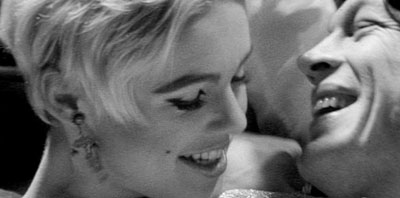BRIGHT LIGHT
By Scott Macaulay
 |
| Edie Sedgwick and Harold Stevenson in an untitled Danny Williams film. |
As many independent filmmakers have sadly realized, the creation of cultural history can be an arbitrary endeavor. The process of making good and innovative work pales against the effort required to make sure that work is actually noticed in the first place. Supportive critics and those all-important "connections" can make the difference between being acclaimed as an innovator or simply forgotten.
Filmmaker and editor Danny Williams was in the right place at the right time, and had the support of influential critics, but he still fell from the history books. In 1965, Williams – Andy Warhol’s lover – lived at the Factory, and designed and ran the groundbreaking Velvet Underground/Exploding Plastic Inevitable light show. But just a year later, while such other Factory personalities as Nico, Edie Sedgwick, and Lou Reed were accumulating considerably more than 15 minutes of fame, Williams disappeared in Massachusetts after attending a family gathering. He was never seen again.
Now, however, Williams’s contributions to underground film and the Factory scene are being revealed through the work of director and producer Esther Robinson. Robinson, currently the Director of Media and Performing Arts for the Creative Capital Foundation, also happens to be Williams’s niece, and her fascination with the legend of her lost uncle and its impact on her own family is behind the construction of her personal documentary, The Danny Williams Story.
Robinson started the project when, as a favor to her 91-year-old grandmother, she began research into Williams’s life. "Danny had had dinner with the family," Robinson recalls, "and went out, saying he needed some air. Six weeks later some workers found a pair of pants, a shirt, and his car keys wedged in a rock near the Boston Bay. Most likely he drowned, but there’s no way to know – we never found a body."
Continues Robinson, "I think it was Jung who said that you are put on earth to solve the problems of your grandparents, and my grandmother asked me to figure this out. When somebody vanishes, they never truly leave. Their unfinished questions get invoked by each successive generation until they are answered."
Robinson’s efforts lead her to the Museum of Modern Art and the Whitney Museum of Art, where curator Callie Angell had just discovered a cache of 26 black-and-white films credited to Williams. Never before seen, these films, which feature Warhol, Sedgwick and the Velvets, among others, display a dramatically different style than either Warhol’s own films or later Factory works by Paul Morrissey.
"Warhol was interested in duration [in his films]," says Robinson, "but Danny’s films reflect an editor’s sensibility. They are kinetic, there are a lot of single-frame edits as well as lots of slow-motion. People will float in the frame, and his lighting was exquisite. His whites glow as people drift in and out of fields of black."
These films plus a box of personal items Williams brought with him from New York to that family gathering 27 years ago are the jumping-off points for her film. Of the box, which contained papers, amphetamine-fueled diaries, lighting diagrams and drugs, Robinson says, "Visual objects can have the weight of an interview. In my film, the visual idea of the past is constantly present."
Glimpses of Robinson’s initial footage indicate that the finished film, however, will be as much a poetic meditation on history and loss as talking-head cultural bio. Working in DV with producer Doug Block, cinematographer Adam Cohen and consulting editor Jim Lyons, Robinson, who previously distributed through her company Wavelength Releasing the "first ever desktop feature," The Last Broadcast, says she wants her own film to share a visual beauty with the works of her uncle. "I feel that I helped usher in this somewhat dubious DV revolution with The Last Broadcast," she notes, "and now I feel that an aesthetic bar has to be raised."
VOD CALENDAR


 See the VOD Calendar →
See the VOD Calendar →


